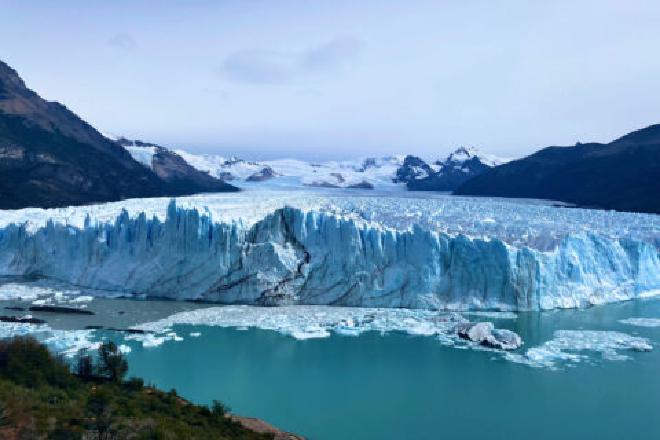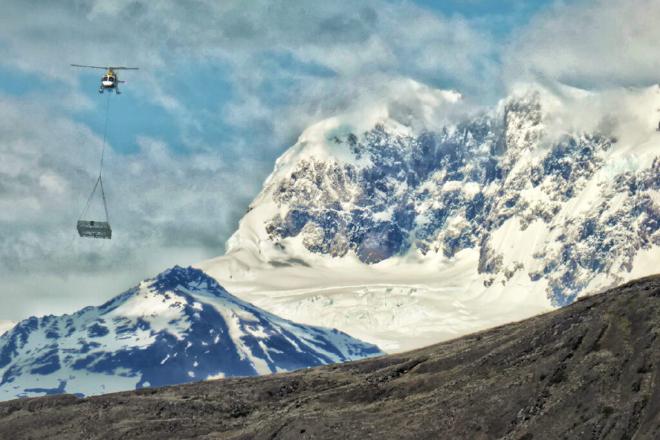

Research predicts end of iconic ice dam events #
One of the most spectacular natural phenomena in the world will most likely no longer be seen in our lifetime: Between 1940 and 2011, the ice masses of the Perito Moreno Glacier in southern Argentina frequently formed ice dams several meters high, dividing the vast lake of Lago Argentino, until the rising water pressure eventually forced its way through the ice dam. Not only the impressive waterfall but also the imposing glacial peaks, from which huge chunks of ice repeatedly broke off and crashed into the lake, attracted many tourists to this otherwise rather remote region. That is likely to be over for several decades now, according to a study by a research team from the Institute of Geography at Friedrich-Alexander-Universität (FAU) Erlangen-Nürnberg. In the journal Nature Communications Earth and Environment, the group reports a rapid decline of the glacier, which until now was considered stable. While other ice masses in Patagonia have retreated significantly, the Perito Moreno Glacier fluctuated back and forth by approximately 50 meters each year until recently. However, the situation has changed dramatically since 2019.
The Perito Moreno Glacier is a 30-kilometre-long glacier in the Argentine Patagonia, fed by the Southern Patagonian Ice Field in the Andes and terminating in Lago Argentino. Declared a UNESCO World Heritage Site in 1981, it is one of the most famous glaciers in the world and is a major Argentinian tourist destination due to its size and accessibility. Unlike most glaciers fed by the Patagonian Ice Fields, Perito Moreno remained relatively stable between 2000 and 2019, retreating by less than 100 metres over the period. However, there has been a substantial increase in the rate of retreat since 2019 — but scientists are unsure why.
Together with the German Aerospace Center (DLR) and partners in Argentina, the FAU group surveyed the glacier using a special radar system. This ground-penetrating radar can scan through the ice to detect the solid ground beneath the glacier. “That is extremely challenging with the large amounts of water often found in Patagonian ice,” explains FAU researcher Moritz Koch.
The surveys also revealed the presence of a large ridge beneath the glacier’s terminus — which the glacier is currently grounded on — that may have been responsible for its pre-2019 stability. The authors caution that if the glacier’s current thinning rate persists, it will detach from the ridge and rapidly retreat for several kilometres, as the increased water depth below the glacier upstream of the ridge will lead to an increased rate of iceberg calving. However, it is not yet clear when this might happen.
Radar measurements by helicopter and by satellite #
At around 250 square kilometers, the Perito Moreno Glacier covers roughly three times the area of the city of Erlangen. To quickly and efficiently measure the thickness of the ice and the glacier bed across this vast area, the radar was mounted on a helicopter. The team also analyzed high-resolution satellite data from the German TanDEM-X mission, which uses a radar system from space to measure the height of the Earth’s surface, including the glacier.

The map of the glacier bed quickly revealed the reason for this acceleration. “Beneath the glacier tongue, there is a rocky ridge that acts like an anchor point,” explains Moritz Koch. This barrier in the bedrock apparently kept the glacier in balance for many decades. Scientists currently believe that after heavy snowfall in the mountains, more iced formed causing Perito Moreno to advance and create an ice dam to the Magellan Peninsula on the other side of Lago Argentino. When precipitation decreased, the glacier retreated a few meters. Overall, however, the anchor point in the bed ensured that the glacier fluctuated relatively little around its equilibrium.
Detaching from its anchor point #
That has now changed: “Our data show that the glacier is currently detaching from its anchor point,” says FAU researcher Moritz Koch, highlighting a key finding of the study. Once the glacier loses its anchor, the process accelerates dramatically. As the ice cover becomes thinner and lighter, the water of Lago Argentino gives the glacier, which rests firmly on the lake bed, more buoyancy. This causes more ice to break off from the glacier tongue, further accelerating the retreat.
Citation #
- The paper The state and fate of Glaciar Perito Moreno Patagonia was published in Nature’s Communications Earth & Environment. Authors: Moritz Koch, Christian Sommer, Norbert Blindow, Katrina Lutz, Pedro Skvarca, Lucas Ruiz, Paola Rizzoli, Jose-Luis Bueso-Bello, Johannes J. Fürst & Matthias H. Braun.
Acknowledgements #
M.K. was funded by the Deutsche Forschungsgemeinschaft via the grant DFG BR 2105/29-1/FU 1032/12-1. M.K. is an affiliated doctoral candidate at the international doctorate programme “Measuring and Modelling Mountain glaciers and ice caps in a Changing ClimAte (M³OCCA), funded by the Elite Network of Bavaria, Germany. J.J.F. received primary funding from the European Union’s Horizon 2020 research and innovation programme via the European Research Council (ERC) as a Starting Grant (FRAGILE project) under grant agreement No 948290. The authors would also like to gratefully acknowledge the scientific support and HPC resources provided by the Erlangen National High Performance Computing Centre (NHR@FAU) of the Friedrich-Alexander-Universität Erlangen-Nürnberg (FAU). NHR funding is provided by federal and Bavarian state authorities. NHR@FAU hardware is partially funded by the German Research Foundation (DFG) - 440719683. We would like to thank the authorities and park rangers from the Parque Nacional Los Glaciares for supporting our field activities throughout our campaigns and for the productive collaboration. We also thank Masahiro Minowa for lending out his transducer for our bathymetric survey. Special thanks to Steffen Welsch for great support in field activities. The TanDEM-X data were kindly provided free of charge by the German Aerospace Centre (DLR) under AO mabra_XTI_GLAC0264.
Funding #
Open Access funding enabled and organized by Projekt DEAL.
- The article Perito Moreno Glacier is detaching from its anchor was published today in Friedrich-Alexander-Universität website
Contact [Notaspampeanas](mailto: notaspampeanas@gmail.com)

